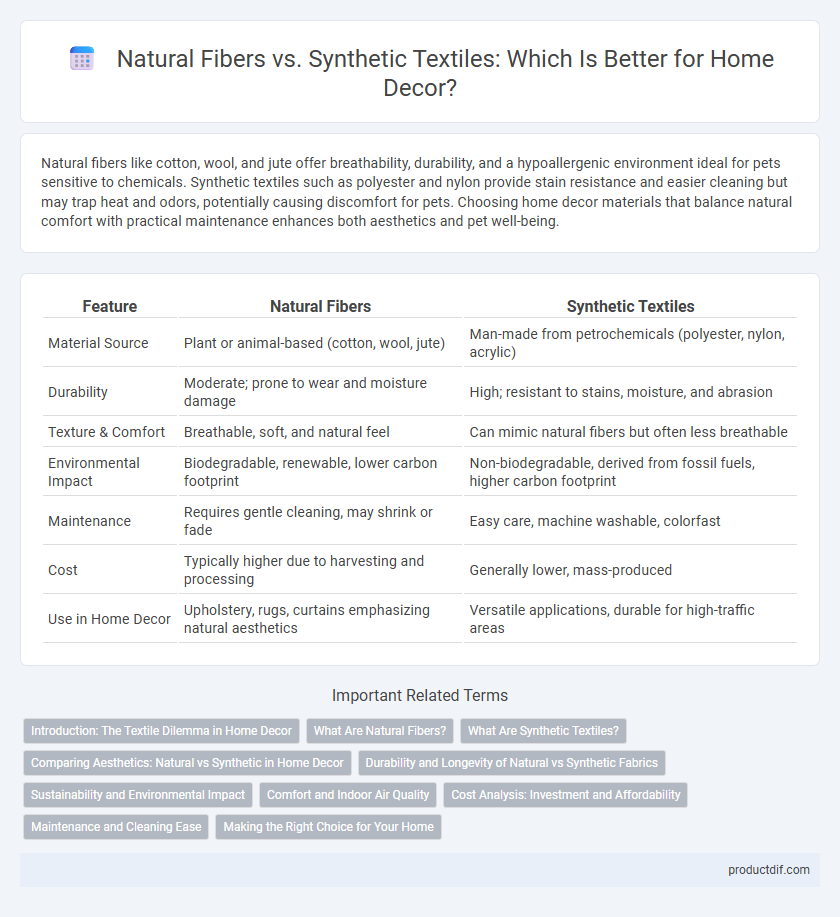Natural fibers like cotton, wool, and jute offer breathability, durability, and a hypoallergenic environment ideal for pets sensitive to chemicals. Synthetic textiles such as polyester and nylon provide stain resistance and easier cleaning but may trap heat and odors, potentially causing discomfort for pets. Choosing home decor materials that balance natural comfort with practical maintenance enhances both aesthetics and pet well-being.
Table of Comparison
| Feature | Natural Fibers | Synthetic Textiles |
|---|---|---|
| Material Source | Plant or animal-based (cotton, wool, jute) | Man-made from petrochemicals (polyester, nylon, acrylic) |
| Durability | Moderate; prone to wear and moisture damage | High; resistant to stains, moisture, and abrasion |
| Texture & Comfort | Breathable, soft, and natural feel | Can mimic natural fibers but often less breathable |
| Environmental Impact | Biodegradable, renewable, lower carbon footprint | Non-biodegradable, derived from fossil fuels, higher carbon footprint |
| Maintenance | Requires gentle cleaning, may shrink or fade | Easy care, machine washable, colorfast |
| Cost | Typically higher due to harvesting and processing | Generally lower, mass-produced |
| Use in Home Decor | Upholstery, rugs, curtains emphasizing natural aesthetics | Versatile applications, durable for high-traffic areas |
Introduction: The Textile Dilemma in Home Decor
Natural fibers such as cotton, linen, and wool offer breathability, durability, and eco-friendliness essential for sustainable home decor. Synthetic textiles like polyester and nylon provide stain resistance, color retention, and affordability, making them popular for high-traffic areas. Choosing between natural fibers and synthetic textiles impacts indoor air quality, comfort, and long-term aesthetic appeal in home environments.
What Are Natural Fibers?
Natural fibers, derived from plants, animals, and minerals, are essential components in sustainable home decor, offering breathability and biodegradability unmatched by synthetic textiles. Examples include cotton, linen, wool, jute, and silk, prized for their durability, moisture-wicking properties, and eco-friendly production. These fibers contribute to healthier indoor environments by minimizing chemical exposure and promoting natural aesthetics in furniture, upholstery, and textiles.
What Are Synthetic Textiles?
Synthetic textiles are man-made fibers produced from petrochemicals, including materials like polyester, nylon, and acrylic, which offer durability and resistance to stains and wrinkles. These fibers are commonly used in home decor for upholstery, curtains, and rugs due to their affordability and versatility. Unlike natural fibers such as cotton or wool, synthetic textiles can be engineered for specific performance qualities, such as moisture-wicking and colorfastness.
Comparing Aesthetics: Natural vs Synthetic in Home Decor
Natural fibers like cotton, linen, and jute offer a warm, organic aesthetic with unique textures and subtle color variations that enhance the cozy ambiance of home decor. Synthetic textiles such as polyester and nylon provide a sleek, uniform finish with vibrant color retention and durability, suited for modern and minimalist design styles. Choosing between natural fibers and synthetic textiles depends on the desired visual appeal and tactile experience, balancing authenticity with practicality in interior spaces.
Durability and Longevity of Natural vs Synthetic Fabrics
Natural fibers such as cotton, wool, and linen offer moderate durability but tend to degrade faster when exposed to sunlight and moisture, making them less ideal for heavy daily use in home decor. Synthetic textiles like polyester and nylon are engineered for enhanced durability, resisting wear, fading, and mildew, which significantly extends their longevity in upholstery, curtains, and rugs. Choosing between natural and synthetic fabrics depends on balancing the aesthetic appeal of natural materials with the practical durability and longer lifespan of synthetic options.
Sustainability and Environmental Impact
Natural fibers such as cotton, wool, and jute offer superior sustainability due to their biodegradability and lower carbon footprint during production compared to synthetic textiles like polyester and nylon, which rely on fossil fuels and contribute significantly to microplastic pollution. The cultivation of natural fibers typically requires fewer chemicals and supports soil health, whereas synthetic fibers often involve toxic chemicals and non-renewable resources that harm ecosystems. Choosing natural fibers in home decor reduces environmental impact and promotes a more eco-friendly, circular textile economy.
Comfort and Indoor Air Quality
Natural fibers such as cotton, wool, and linen offer superior breathability and moisture-wicking properties, enhancing indoor comfort by regulating temperature and humidity. These fibers are less likely to emit volatile organic compounds (VOCs), contributing to better indoor air quality compared to synthetic textiles made from petroleum-based fibers like polyester and nylon. Choosing natural fibers in home decor reduces exposure to allergens and toxins, promoting a healthier living environment.
Cost Analysis: Investment and Affordability
Natural fibers such as cotton, wool, and jute typically involve higher upfront costs due to sustainable sourcing and quality craftsmanship, offering long-term durability and biodegradability. Synthetic textiles like polyester and nylon are generally more affordable initially, benefiting from mass production and lower material expenses but may incur higher replacement costs over time due to reduced lifespan and environmental impact. Evaluating investment in home decor involves balancing the premium of natural fibers' eco-friendliness and durability against the budget-friendly, yet less sustainable, nature of synthetic materials.
Maintenance and Cleaning Ease
Natural fibers like cotton, jute, and wool require gentle cleaning methods, often needing hand washing or dry cleaning to maintain texture and prevent damage. Synthetic textiles such as polyester and nylon offer greater resistance to stains and are typically machine washable, making them easier to maintain for busy households. Choosing between these materials depends on balancing the desire for eco-friendly options against the convenience of low-maintenance care routines.
Making the Right Choice for Your Home
Choosing between natural fibers like cotton, wool, and jute versus synthetic textiles such as polyester or nylon significantly impacts your home's ambiance and sustainability. Natural fibers offer breathability, biodegradability, and a softer texture, enhancing comfort and eco-friendliness in your living space. Synthetic textiles provide greater durability, stain resistance, and affordability, ideal for high-traffic areas requiring easy maintenance.
Natural Fibers vs Synthetic Textiles Infographic

 productdif.com
productdif.com